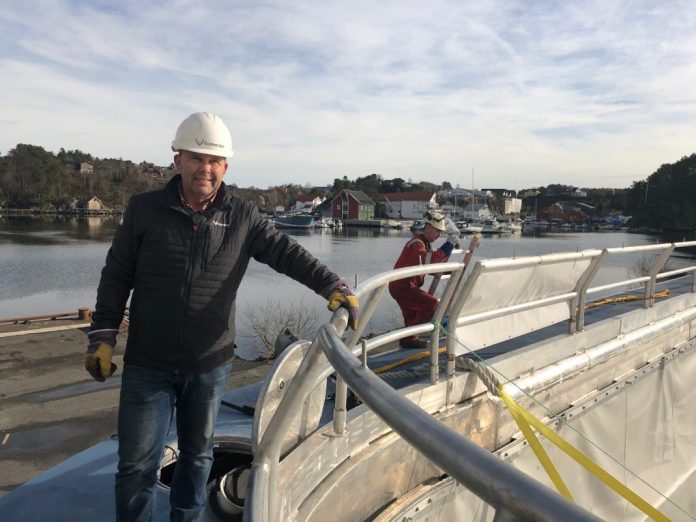An innovative new cage solution will keep lice and disease away from fish.
It shines in glossy aluminium, catching the rays on the quay. The frame is 1,000 square meters. Ecomerden’s new product holds 22,000 cubic metres of water.

“Now it’s wrapping up here,” said Ecomerden’s Fredrik Kyrkjebø as he briefly greeted me, before rushing up the ladder to the cage edge.
A curious group of swans gather to take a look at the colossus in the factory hall in Sagvåg in Stord, an island south of Bergen, Western Norway. There has been shipbuilding here for many decades.
Split up
“It can be used for both on-growing fish and broodstock, and can be divided into four individual cages. It’s square since the fish have to be sorted. There are not so many individuals. It can carry up to 100 tonnes of fish per cage, so total of 400 tonnes,” explained inventor, engineer and Ecomerden founder Jan Erik Kyrkjebø to SalmonBusiness.
Their main motivation is to prevent lice infestation and disease on the fish.

“If we had scaled up with oxygen, we could have up to one million fish per Ecomerd,” Kyrkjebø continued. “It is a commercial facility. The first, as far as I know, commercial semi-closed cage that was not delivered to R&D or development licenses. So we are in a commercial phase.”
The strong but only three-millimetre thick canvas is developed by two suppliers, namely German Hitex and French Serge Ferrari. It’s basically a standard cage enclosed with a tightly flexible canvas. There is no cleaning on the water in or out of the cage, nor does it have UV and particle filters, or a waste collection normally required from closed cages.

Broodstock
About 25,000 broodstock will be put into the cage, according to fish farmer Osland Havbruk operations manager Johnny Kalstad.
It will be located at Osland, on the King of the Fjords in Western Norway.
“The starting point was that we were planning to have post-smolt, but then we saw that we had big problems with lice on broodstock on the second year in the sea. Then we’ll test it out. It is clear that broodstock are valuable fish,” he emphasised.
View this post on Instagram
Family groups
The tribal fish will be Osland’s own trout breeding stock, which has its ancestors dating back to the entrepreneurial era in the early 1960s.
“It will be an exciting project. It will be divided into four parts, with different family buds and test groups, with a common canvas. We think that if we get to this, we will make larger post-smolt and have shorter time in open cages. But there are many pitfalls there too: Disease and that one cannot put the fish out at different times. Broodstock fish are passive and accumulate sea lice.”



